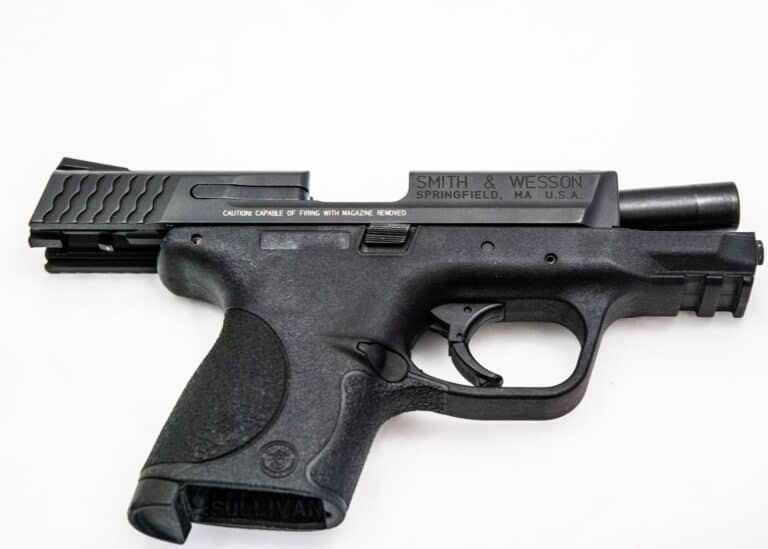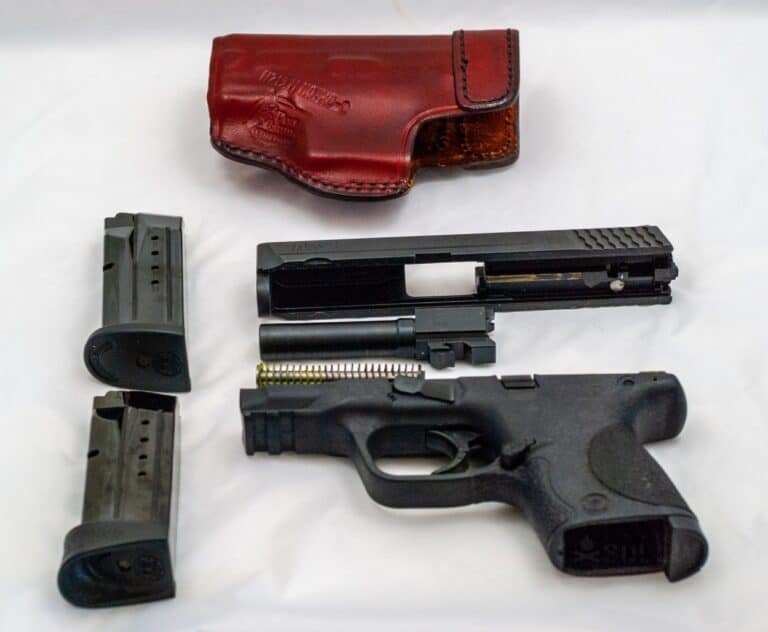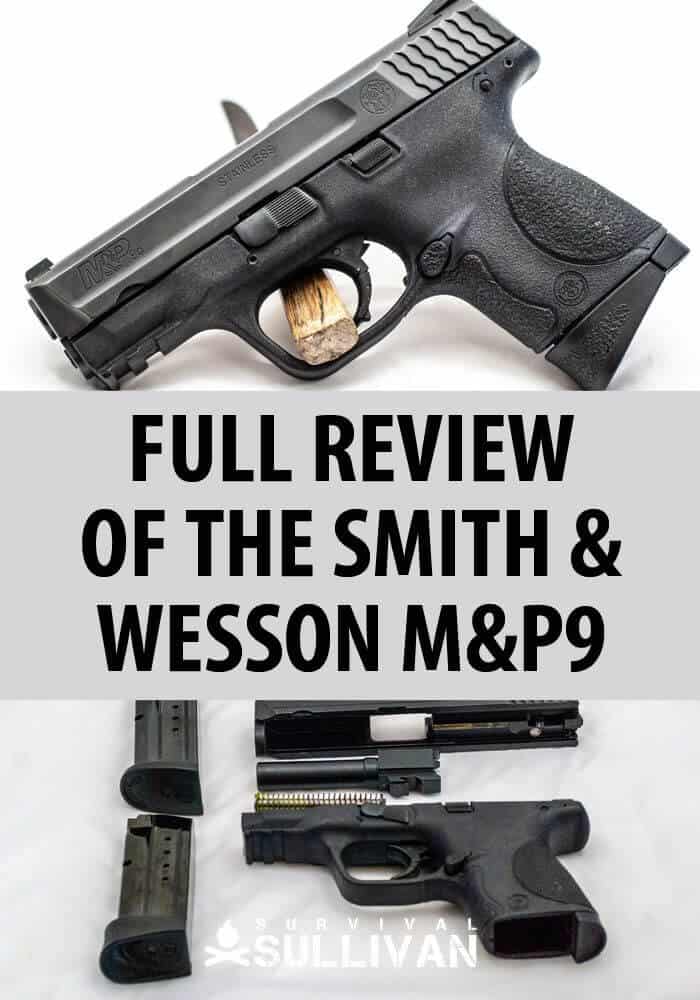The striker-fired pistol category was not always so flush with choices, something that may be taken for granted by newer entrants into the gun world. From the late 1980s through the mid 1990s, polymer striker-fired guns as a category were still comparatively nascent.

Glock was the out-in-front choice, but then not yet completely dominant. Walther’s P99 showed considerable innovation and helped introduce many features that are seen as standard equipment on new guns in this class, but never saw much success in the U.S., though its international use is quite common.
Smith & Wesson’s first attempt at a polymer striker-fired gun, the Sigma, was at best a minor debacle, and relegated to history as a failure, not a marvel and certainly not an icon. But Smith & Wesson would not quit the fight for the polymer market share so easily.
By taking their licks and learning what lessons defeat had to teach them, it would only be a few years later they would unveil what is today one of the best striker-guns on the market today: the M&P.
From a buggy initial rollout to its lofty position today as one of the premier American made guns in its category, the M&P has proven itself a reliable and user-friendly handgun for civilian, military or law enforcement use, one worthy of the Military & Police livery.
Today we will examine the M&P at length; it’s characteristics, design, failings, successes and all.
Table of Contents
Birth of the M&P
For almost since the entirety of their existence, Smith & Wesson has made rugged, reliable and dependable guns that could be counted on to bring their wielders back out of harm’s way.
This company’s track record of successful designs and more than two handfuls of legendary pistols is testament to their more than 150 years of continuous innovation and quality production.
From the enormous Model 29 which permanently embossed magnum wheelguns into the public consciousness to the Model 39 service pistol which shepherded U.S. domestic manufacturing into DA/SA pistols, the list of firsts and achievement goes on for decades.
But it is the stalwart and sturdy Model 10, a simple DA/SA revolver, which first flew the “M&P” banner, and is the spiritual if not mechanical ancestor of the modern M&P semi-auto.
But the proper inception of the M&P as it were, actually begins in the year 1994.The prologue is this: the early 1990’s was a period of considerable innovation in handguns.
Glock, while ascendant, had not yet managed to completely and utterly dominate the police market. Striker-fired handguns were gaining steam quickly as the technology to beat, but were not yet universally loved by the shooting public at large.
At the same time, a new intermediate pistol cartridge bearing S&W’s name, the .40 Smith & Wesson, was ahead of a conflux of events that would see it come to dominate American police issuance for at least the next 12 years.
Glock pulled off a minor coup by releasing a new pistol in 1990, the Glock Model 22 chambered in Smith & Wesson’s new cartridge, before S&W got it to market. While this resulted in a certain amount of egg on their faces, S&W charged ahead with their new, competing pistol, one intended to go head to head with the Glock, and win.
While it took them 3 ½ years to catch up, in 1994 Smith & Wesson unveiled the Sigma SW40, a pistol that mimicked the Glock on all points.
In fact, you might even say mimicked is too soft a word. Copied, utterly, is more appropriate, and not in a favorable way. The Sigma was so close in design to the Glock that Glock dragged S&W to court for patent infringement.
This suit was successful, and S&W settled for an as of today unknown amount of money, a blow which left their image blemished and confidence singed, but were able to keep on producing Sigmas in the bargain.
The Sigma pistol was not a liked or likeable gun: they were ok, in as much as they reliable enough (though nowhere close to its inspiration’s tank-like ruggedness), but suffered from crappy controls, terrible triggers and none of the Glock’s cult appeal.
Inarguably, the Sigma’s most important contribution to the history of the pistol is that it would serve as the basis for much of the later M&P’s design, akin to flinging a light into the future.
After the Sigma premiered with a wet, shivery pop and would later commercially died with a dry rattle, S&W forsook their plans of striker-fired market share until the year 1999.
Due to their partnership with Walther of Germany, and still keen to piggyback on the success of a European pistol, S&W, in a mildly baffling move, remixed Walther’s excellent P99 as their own SW99.
While the P99 was and is n excellent service pistol and one well like across the world and by aficionados here in the U.S., it never really caught on here domestically. But compared to the SW99, it was a rockstar; the SW99, while superior in every regard to its Sigma predecessor, did not have the chops to carve out civilian or police market share.
As far as plastic pistols were concerned, things looked grim for Smith & Wesson: two back-to-back flops and they were sued for their trouble on one of them.
After years of mismanagement, slumping sales and executive leadership who was hopelessly out of touch with their core customer demographic (crowned by their collaboration with Bill Clinton’s White House on the 1994 Assault Weapons Ban), Smith & Wesson was purchased for pennies by the Saf-T-Hammer Corporation. Any outsider would say that the sun was setting on the grand, old American maker.
But that was not to be. The change in ownership brought new leadership, and with it renewed vision and purpose. In the middle of the 2000’s, the striker pistol market had finally grown fat and stagnant: Glock was an overwhelming leader in the market, and any other polymer gun that ran against their supremacy seemed only trying to outdo them on novelty.
But Glock grew somewhat lazy, and rested on their laurels, with no major innovation coming from Austria save new calibers and new sizes.
Sensing an opportunity, and sagely understanding the shooting public’s perhaps unrealized need for refinement more so than innovation, Smith & Wesson unveiled the new M&P series in 2005.
These striker-fired guns banked everything on simply shoring up the Glock’s weaknesses while retaining the action and operating system that was such a sea-change for the gun sphere.
The renewed M&P livery boldly proclaiming their intent, S&W’s new pistol brought ambidextrous controls, better ergonomics, a far nicer stock trigger and adjustable grips.
Despite a few initial issues with slide release breakage and some bad barrels, the pistol proved reliable and very easy to shoot well. In no time at all, it was gaining steam with civilian shooters and just a few years after that with law enforcement.
Glock’s first serious competition had arrived; Smith & Wesson finally had their polymer thoroughbred.
Characteristics
The M&P9 is an excellent pistol, but not one that is terribly innovative mechanically. This is not a bad thing. The barrel on the fullsize pistol is appx. 4 ¼”, of common Browning-style locking action and features a small port, or peephole on top to allow visually verification of a loaded chamber, light permitting, with no manipulation of the slide (a “press check”) needed.
The polymer frame incorporates a beefy, steel sub frame, or chassis, that lends strength and stiffness over and above what similar polymer competitors’ guns offer, ones that utilize only slide rail inserts.
The grip hold a voluminous 17 round magazine, and features a tool-less interchangeable grip shell arrangement, allowing one of three included sizes to be fitted for user preference. The dustcover includes the now common accessory rail for a light or laser.
Note: the rail is not “Picatinny” standard, but fits all major manufacturers systems to this author’s knowledge.
The control layout is worthy of note: one of the first polymer striker guns to incorporate such a feature, the M&P9 has dual ambidextrous slide releases just above and behind the trigger guard.
Unlike the Glock, the stock releases are more than pronounced enough to allow their use for the intended function, not just the locking open of the slide. The magazine release in a button in thy typical place for American tastes as befits a highly American pistol.
The trigger is of constant action utilizing a partially pre-cocked striker as with the Glock and many other polymer guns of this kind. The stock trigger across all M&P models is inarguably superior to the Glock’s.
Of some interest, the trigger safety, a virtual necessity on striker pistols, omits the Glock’s inset “blade” for a pivoting, hinged, two piece trigger to accomplish the same function.
Speaking of safeties, the M&P9, and many of the other M&P models have available an optional manual safety which is located at the rear of the frame in the same arrangement of a 1911- up is safe, down is fire.
This setup is excellent ergonomically and another advantage that the M&P has to confer to those who desire a thumb safety.
Moving up to the Melonite-coated slide, you will find S&W’s distinctive scalloped slide serrations fore and aft which offer an excellent grip for retracting the slide for any reason. Stock sights are steel on the S&W, as opposed to plastic on the earlier Glock iterations, and are of common 3-dot pattern.
Lastly, disassembly of the M&P9 is easily accomplished by rotation of a frame mounted lever when the slide is locked to the rear. Once accomplished, a small disconnector lever inside the magazine well is swung down out of position before releasing the slide and easing it forward off the frame.

This small added element to disassembly omits the necessity of pulling the trigger to remove the slide, which is no doubt a huge relief to police administrators whose departments issue the M&P.
As alluded to previously, while the M&P shows obvious heritage to its Sigma parentage, and borrows some ergonomic cues from the SW99, it shares no components with either of its predecessors.
Teething Problems
The M&P series as a whole, and especially the M&P9, are greatly lauded and popular today, but as with many new products of all stripes that first run “public beta test” revealed some troubles.
The most notorious and common of these quickly made itself known almost immediately upon launch, but others took some time to fully reveal their scope and severity.
The most common issue with the early guns was a snapped off slide release lever as a result of a minor design flaw. This was subsequently fixed in follow-on production runs but did no favors for the pistol at first.
The other major gripe was over serious rusting occurring whenever the pistol or its magazines were exposed to sweat or bad weather. This was traced to improperly applied finishes at the factory, and should not be counted as a knock against Melonite as a finish material.
Melonite, actually one of several trade names for nitrocarburizing, is an extraordinarily wear and corrosion resistant finish so long as it, obviously is applied properly.
As of today, it is the rare person who will have any issues with rusting on their M&P, though some poor souls who carry guns seem to rust them as quickly as hot coffee dissolves sugar. While tough to believe, some individuals’ body chemistry is highly hostile to metals, and will rust nearly any in prolonged contact with their sweat.
The last and somewhat more insidious issue was complaints of poor accuracy from the M&P, especially the 9mm. This issue was tough to sort out definitively, but was finally declared to result from a too slow rifling twist, though rumors of janky chambers persist.
Regardless of these early hiccups, the M&P’s of today have proven themselves reliable, accurate and thoroughly dependable handguns.
OEM and Aftermarket Support, Upgrades and More
While not quite on the same level and breadth as the Glock, the M&P family of pistols enjoys significant support from Smith & Wesson and has spawned a thriving aftermarket of parts and accessories for your customizing pleasure: drop-in barrels, fitted barrels, triggers of all stripes and kinds, larger controls, smaller controls, extended magazines, magazine extensions, sights, optics and much, much more.
This is always a good thing, as a pistol need not be limited in the hands of an excellent shooter by its baked-in factory configuration. For those who see a pistol as only a starting point, you can take an M&P as far into enhanced territory as you like.
The M&P9 is without doubt a rock solid base gun, and one that will provide most shooters with all the performance they require, but better is always, well, better. If you desire a higher ceiling of performance you might consider one of S&W’s in-house tuned models from the Performance Center.
These guns have everything from super-tuned actions and triggers to factory milled slides for direct mounting of MRDS’s. If you have the cash, one of these upgraded models may be just the ticket without delving into the rabbit hole of installing, fitting and testing compatibility between aftermarket mods.
Aside from the enhanced Performance Center guns, Smith & Wesson recently rolled out the second generation M&P’s, dubbed the M2.0 M&P. As the M&P addressed the most common complaints and shortcomings of the Glock, the M2.0 M&P’s address the most common wants and complaints of the M&P.
The trigger has for starters been noticeably cleaned up with a cleaner break and a crisp, defined reset for those who desire it to be tactile in operation.
The aforementioned steel chassis was lengthened and strengthened in a redesign for better rigidity and durability. While the original M&P was by no means a flimsy pistol and the necessity of such an upgrade may be questioned, you can be assured the minds in the R&D lab at S&W are on the case with a passion.
The grip and its inserts are also now roughly textured right out of the box, a wise move on Smith & Wesson’s part as in my mind the most common grievance of nearly any production pistol today is that it is just too damn slick and hard to hand on to with anything less than dry, clean hands.
Look for a moment at the sheer number of grip enhancements shooter’s perform on their pistols, either homebrewed or professionally applied: new grips, checkering, stippling grip tape. You must be able to hang on to your pistol in a fight, and a better grip means more control, comfort be damned, so this is a welcome improvement.
Legacy
The M&P series guns are showing no signs of slowing down and have the chops to be the progenitors of an excellent family of pistols. Aside from the fullsize M&P9 describer here, S&W makes the common subcompact M&P9C, long slide variations as mentioned and has also introduced slim single stack versions known as the M&P Shield, in calibers as small as .380 ACP.
M&P’s have since steadily gained ground on in the U.S. law enforcement market as well as enjoying remarkable success in the civilian sector. With continual refinement, upgrading and service life improvement ongoing, you can bet your last nickel that the M&P will remain the base platform for Smith & Wesson’s striker fired fleet going forward.
There is no telling from here what shape S&W’s Next Big Thing may take, or what cherished heraldry it will call on, but you can rest assured it will have to be a exceptional pistol to surpass the M&P; the gun that finally cast off S&W’s old shame and failings.
Should You Get it?
The M&P’s are one of the best domestic made striker-fired pistols available, and one of the first guns to compete with Glock on equal footing.
Hundreds of thousands of professional and civilian shooters depend on and enjoy the M&P for duty, self-defense and competition. If you want one of the premier polymer striker fired guns on the market today, the M&P9 must warrant serious consideration.


Charles Yor is an advocate of low-profile preparation, readiness as a virtue and avoiding trouble before it starts. He has enjoyed a long career in personal security implementation throughout the lower 48 of the United States.

What about the Sig Sauer P365. No recognition or comment.